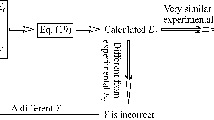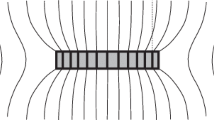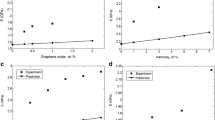Abstract
In this work, the interphase in polymer nanocomposites is modeled as a multilayered part in which the Young’s modulus of each layer Ek continuously changes from nanoparticle surface (xk = 0) to polymer matrix (xk = t). The dependency of Ek onxk is analyzed by linear, exponential and power functions. The average interphase modulus is determined by the Ji model for several samples and the accurate dependency ofEk on x is derived. The linear and exponential relations display a relatively similar trend forEk, but they cannot suggest an accurateEk assuming the predicted interphase modulus by the Ji model. The equation which relatesEk onxkY can present acceptable values for Ek, where the value ofY determines the Young’s modulusEk. This approach can be applied to evaluate the magnitude of interphase in polymer nanocomposites.




Similar content being viewed by others
REFERENCES
Zare, Y. and Rhee, K., Evaluation and Development of Expanded Equations Based on Takayanagi Model for Tensile Modulus of Polymer Nanocomposites Assuming the Formation of Percolating Networks,Phys. Mesomech., 2018, vol. 21, no. 4, pp. 351–357.
Badamshina, E.R., Goldstein, R.V., Ustinov, K.B., and Estrin, Ya.I., Strength and Fracture Toughness of Polyurethane Elastomers Modified with Carbon Nanotubes, Phys. Mesomech., 2018, vol. 21, no. 3, pp. 187–192.
Zare, Y., Garmabi, H., and Rhee, K.Y., Structural and Phase Separation Characterization of Poly (Lactic Acid)/Poly (Ethylene Oxide)/Carbon Nanotube Nanocomposites by Rheological Examinations,Compos. B. Eng., 2018, vol. 144, pp. 1–10.
Nikfar, N., Zare, Y., and Rhee, K.Y., Dependence of Mechanical Performances of Polymer/Carbon Nanotu-bes Nanocomposites on Percolation Threshold, Physica B. Condens. Matter, 2018, vol. 533, pp. 69–75.
Zare, Y. and Rhee, K.Y., Dependence of Z Parameter for Tensile Strength of Multi-Layered Interphase in Polymer Nanocomposites to Material and Interphase Properties, Nanoscale Res. Lett., 2017, vol. 12, p. 42.
Naghib, S.M., Rabiee, M., and Omidinia, E., Electroanalytical Validation of a Novel Nanobiosensing Strategy and Direct Electrochemistry of Phenylalanine Dehydrogenase for Clinical Diagnostic Applications, Int. J. Electrochem. Sci., 2014, vol. 9, pp. 2301–2315.
Kalantari, E., Naghib, S.M., Naimi-Jamal, M.R., and Mozafari, M., Green Solvent-Based Sol–Gel Synthesis of Monticellite Nanoparticles: a Rapid and EfficientApproach, J. Sol-Gel Sci. Tech., 2017, vol. 84, pp. 87–95.
Salahandish, R., Ghaffarinejad, A., Naghib, S.M., Majidzadeh-A, K., Zargartalebi, H., and Sanati-Nezhad, A., Nano-Biosensor for Highly Sensitive Detection of HER2 Positive Breast Cancer, Biosensor. Bioelectron., 2018, vol. 117, pp. 104–111.
Khoramishad, H., Khakzad, M., and Fasihi, M., The Effect of Outer Diameter of Multi-Walled Carbon Nanotubes on Fracture Behavior of Epoxy Adhesives, Sci. Iran. Trans. B. Mech. Eng., 2017, vol. 24, pp. 2952–2962.
Khoramishad, H., Ebrahimijamal, M., and Fasihi, M., The Effect of Graphene Oxide Nano-Platelets on Fracture Behavior of Adhesively Bonded Joints, Fatig. Fract. Eng. Mater. Struct., 2017, vol. 40, pp. 1905–1916.
Zare, Y. and Rhee, K.Y., Simplification and Development of McLachlan Model for Electrical Conductivity of Polymer Carbon Nanotubes Nanocomposites Assuming the Networking of Interphase Regions, Compos. B. Eng., 2019, vol. 156, pp. 64–71.
Liu, Z., Peng, W., Zare, Y., Hui, D., and Rhee, K.Y., Predicting the Electrical Conductivity in Polymer Carbon Nanotube Nanocomposites Based on the Volume Fractions and Resistances of the Nanoparticle, Interphase, and Tunneling Regions in Conductive Networks, RSC Advanc., 2018, vol. 8, pp. 19001–19010.
Razavi, R., Zare, Y., and Rhee, K.Y., A Two-Step Model for the Tunneling Conductivity of Polymer Carbon Nanotube Nanocomposites Assuming the Conduction of Interphase Regions, RSC Advanc., 2017, vol. 7, pp. 50225–50233.
Ma, X., Zare, Y., and Rhee, K.Y., A Two-Step Methodology to Study the Influence of Aggregation/Agglomeration of Nanoparticles on Young’s Modulus of Polymer Nanocomposites, Nanoscale Res. Lett., 2017, vol. 12, p. 621.
Zare, Y. and Rhee, K.Y., A Power Model to Predict the Electrical Conductivity of CNT Reinforced Nanocomposites by Considering Interphase, Networks and Tunneling Condition,Compos. B. Eng., 2018, vol. 155, pp. 11–18.
Sadeghi, A., Moeini, R., and Yeganeh, J.K., Highly Conductive PP/PET Polymer Blends with High Electromagnetic Interference Shielding Performances in the Presence of Thermally Reduced Graphene Nanosheets Prepared Through Melt Compounding, Polymer Compos., 2018, vol. 40, pp. E1461–E1469.
Sanjari Shahrezaei, M.A., Goharpey, F., and Kha-demzadeh Yeganeh, J., Effect of Selective Localization of Cellulose Nanowhiskers on Viscoelastic Phase Separation, Polymer Eng. Sci., 2018, vol. 58, pp. 928–942.
Rostami, A., Vahdati, M., and Nazockdast, H., Unraveling the Localization Behavior of MWCNTs in Binary Polymer Blends Using Thermodynamics and Viscoelastic Approaches, Polymer Compos., 2018, vol. 39, pp. 2356–2367.
Rostami, A., Vahdati, M., Alimoradi, Y., Karimi, M., and Nazockdast, H., Rheology Provides Insight into Flow Induced Nano-Structural Breakdown and Its Recovery Effect on Crystallization of Single and Hybrid Carbon Nanofiller Filled Poly (Lactic Acid),Polymer, 2018, vol. 134, pp. 143–154.
Zare, Y. and Garmabi, H., Analysis of Tensile Modulus of PP/Nanoclay/CaCO3 Ternary Nanocomposite Using Composite Theories, J. Appl. Polymer Sci., 2012, vol. 123, pp. 2309–2319.
Shabana, Y.M., A Micromechanical Model for Composites Containing Multi-Layered Interphases, Compos. Struct., 2013, vol. 101, pp. 265–273.
Boutaleb, S., Zarri, F., Mesbah, A., Nart-Abdelaziz, M., Gloaguen, J.-M., Boukharouba, T., and Lefebvre, J.-M., Micromechanics-Based Modelling of Stiffness and Yield Stress for Silica/Polymer Nanocomposites, Int. J. Solid. Struct., 2009, vol. 46, pp. 1716–1726.
Romanowicz, M., Progressive Failure Analysis of Unidirectional Fiber-Reinforced Polymers with Inhomogeneous Interphase and Randomly Distributed Fibers under Transverse Tensile Loading, Compos. A. Appl. Sci. Manufact., 2010, vol. 41, pp. 1829–1838.
Zhong, Y., Wang, J., Wu, Y.M., and Huang, Z., Effective Moduli of Particle-Filled Composite with Inhomogeneous Interphase: Part II—Mapping Method and Evaluation, Compos. Sci. Tech., 2004, vol. 64, pp. 1353–1362.
Zare, Y., Fasihi, M., and Rhee, K.Y., Efficiency of Stress Transfer between Polymer Matrix and Nanoplatelets in Clay/Polymer Nanocomposites, Appl. Clay Sci., 2017, vol. 143, pp. 265–272.
Zare, Y. and Rhee, K.Y., Multistep Modeling of Young’s Modulus in Polymer/Clay Nanocomposites Assuming the Intercalation/Exfoliation of Clay Layers and the Interphase between Polymer Matrix and Nanoparticles, Compos. A. Appl. Sci. Manufact., 2017, vol. 102, pp. 137–144.
Zare, Y., Rhee, K.Y., and Park, S.-J., Predictions of Micromechanics Models for Interfacial/Interphase Parameters in Polymer/Metal Nanocomposites, Int. J. Adhes. Adhesives, 2017, vol. 79, pp. 111–116.
Razavi, R., Zare, Y., and Rhee, K.Y., A Model for Tensile Strength of Polymer/Carbon Nanotubes Nanocomposites Assuming the Percolation of Interphase Regions, Colloid. Surf. A. Physicochem. Eng. Aspects, 2018, vol. 538, pp. 148–154.
Amraei, J., Jam, J.E., Arab, B., and Firouz-Abadi, R.D., Modeling the Interphase Region in Carbon Nanotube-Reinforced Polymer Nanocomposites, Polymer Compos., 2019, vol. 40, pp. E1219–E1234.
Hassanzadeh-Aghdam, M., Mahmoodi, Ansari, R., and Darvizeh, A., Interphase Influences on the Mechanical Behavior of Carbon Nanotube–Shape Memory Polymer Nanocomposites: A Micromechanical Approach, J. Intell. Mater. Syst. Struct., 2018. doi 1045389X188 12704
Ji, X.L., Jing, J.K., Jiang, W., and Jiang, B.Z., Tensile Modulus of Polymer Nanocomposites, Polymer Eng. Sci., 2002, vol. 42, pp. 983–993.
Zare, Y. and Garmabi, H., Thickness, Modulus and Strength of Interphase in Clay/Polymer Nanocomposites, Appl. Clay Sci., 2015, vol. 105, pp. 66–70.
Zare, Y. and Garmabi, H., A Developed Model to Assume the Interphase Properties in a Ternary Polymer Nanocomposite Reinforced with Two Nanofillers, Compos. B. Eng., 2015, vol. 75, pp. 29–35.
Chang, Y.W., Kim, S., and Kyung, Y., Poly (Butylene Terephthalate)–Clay Nanocomposites Prepared by Melt Intercalation: Morphology and Thermomechanical Properties, Polymer Int., 2005, vol. 54, pp. 348–353.
Kontou, E. and Niaounakis, M., Thermo-Mechanical Properties of LLDPE/SiO2 Nanocomposites, Polymer, 2006, vol. 47, pp. 1267–1280.
Yeh, M.-K., Hsieh, T.-H., and Tai, N.-H., Fabrication and Mechanical Properties of Multi-Walled Carbon Nanotubes/Epoxy Nanocomposites, Mater. Sci. Eng. A, 2008, vol. 483, pp. 289–292.
Isayev, A., Kumar, R., and Lewis, T.M., Ultrasound Assisted Twin Screw Extrusion of Polymer–Nanocomposites Containing Carbon Nanotubes, Polymer, 2009, vol. 50, pp. 250–260.
Grosberg, A.Y. and Kuznetsov, D., Quantitative Theory of the Globule-to-Coil Transition. 1. Link Density Distribution in a Globule and Its Radius of Gyration, Macromolecules, 1992, vol. 25, pp. 1970–1979.
Zare, Y., Effects of Interphase on Tensile Strength of Polymer/CNT Nanocomposites by Kelly–Tyson Theory, Mech. Mater., 2015, vol. 85, pp. 1–6.
Pukanszky, B., Influence of Interface Interaction on the Ultimate Tensile Properties of Polymer Composites,Composites, 1990, vol. 21, pp. 255–262.
Nicolais, L. and Narkis, M., Stress-Strain Behavior of Styrene-Acrylonitrile/Glass Bead Composites in the Glassy Region,Polymer Eng. Sci., 1971, vol. 11, pp. 194–199.
Piggott, M. and Leidner, J., Misconceptions about Filled Polymers, J. Appl. Polymer Sci., 1974, vol. 18, pp. 1619–1623.
Author information
Authors and Affiliations
Corresponding author
Additional information
Russian Text © The Author(s), 2019, published in Fizicheskaya Mezomekhanika, 2019, Vol. 22, No. 3, pp. 100–105.
Rights and permissions
About this article
Cite this article
Zare, Y., Rhee, K.Y. A Modeling Approach for Young’s Modulus of Interphase Layers in Polymer Nanocomposites. Phys Mesomech 23, 176–181 (2020). https://doi.org/10.1134/S1029959920020095
Received:
Revised:
Accepted:
Published:
Issue Date:
DOI: https://doi.org/10.1134/S1029959920020095




